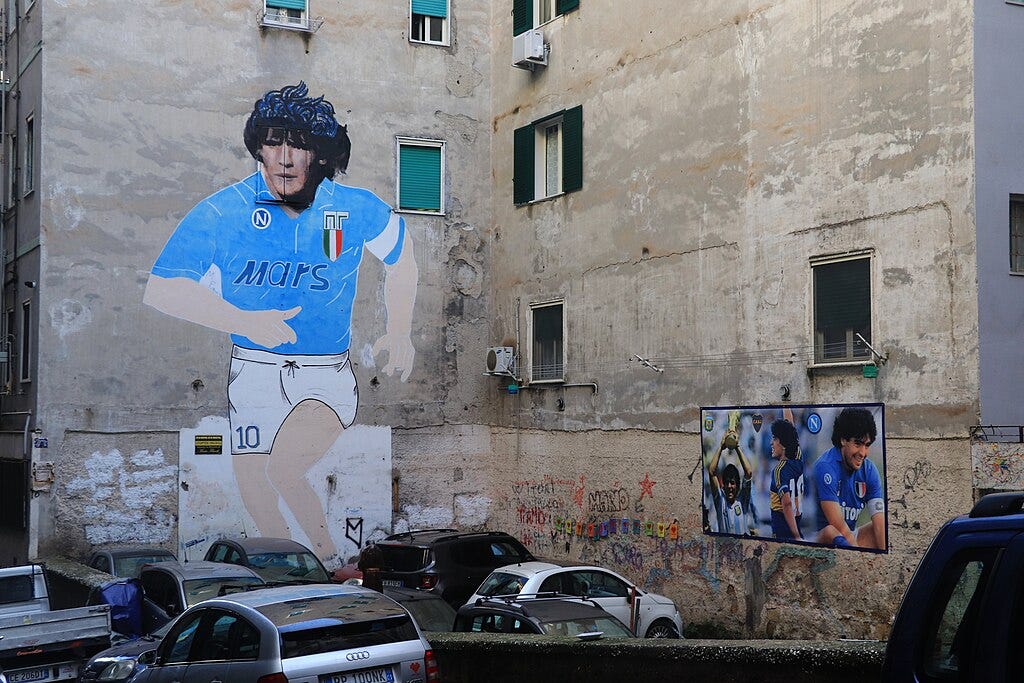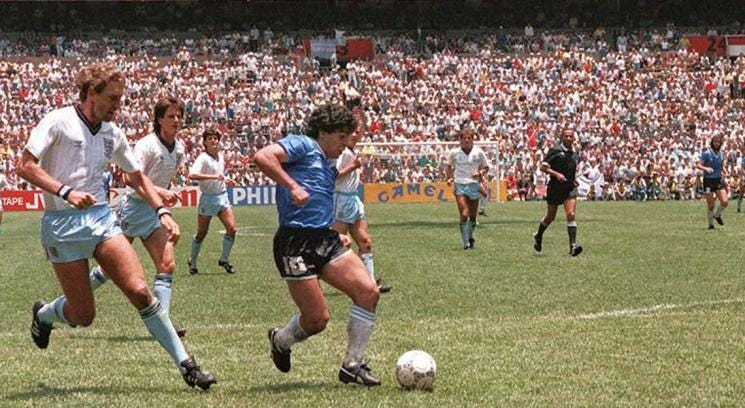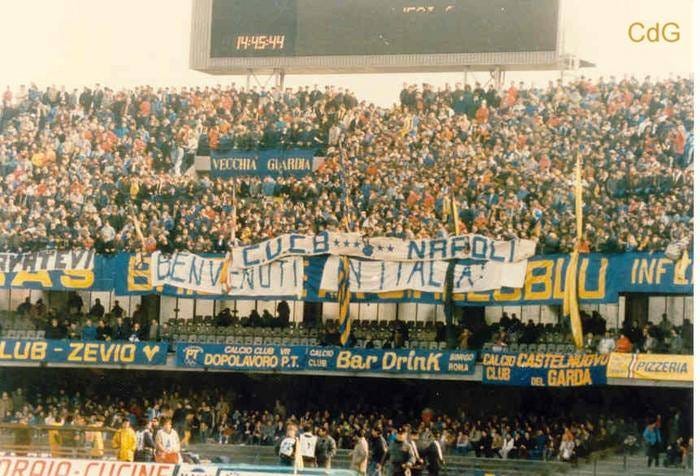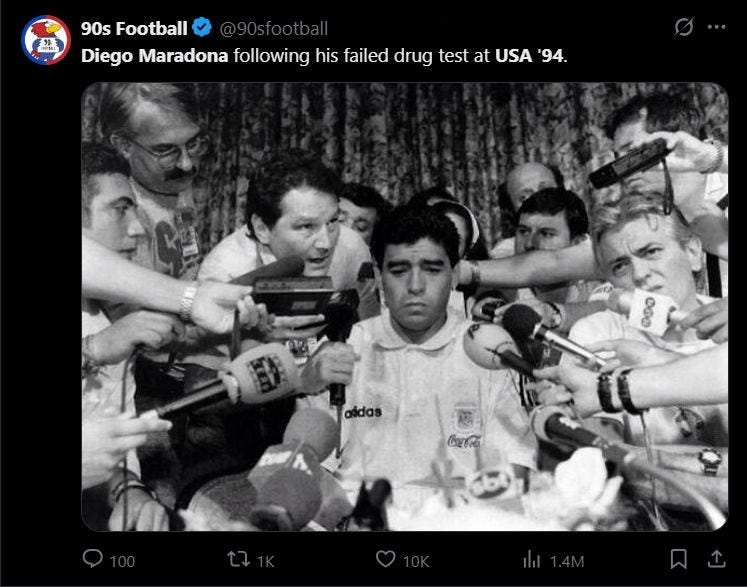
Diego Maradona grew up in a squatter camp with his parents, Doña Tota and Don Diego Senior, along with his seven siblings. At the age of 10, his friend Goyo Carrizo insisted that Francisco Cornejo, the Argentinos Juniors youth academy coach, watch Diego play. When Don Francis first saw him touch the ball, he thought Diego wasn’t a child but a dwarf—because no kid could possess such talent. Don Francis was even embarrassed to ask Diego’s mother for his birth certificate in order to sign him and let El Pibe de Oro play for Cebollitas de Argentinos Juniors.
That moment marked the beginning of Diego Armando Maradona’s story. He is one of the most fitting players to illustrate the intersection of football and politics. Through football, he proved that one could climb the social ladder while also advocating for social and political change on behalf of the underprivileged. As Sócrates taught us, there is nothing more Marxist than football, and Maradona embodied this idea perfectly.
Maradona has always been compared to Pelé, another monstre sacré of football. The key difference between them is that Pelé won his trophies alongside teammates who could have won even without him, whereas Maradona led a team of outsiders to victory.
Football fans have long debated whether Lionel Messi could surpass his master. The truth is, Messi is akin to Michael Jordan—an extraordinary athlete solely focused on the game. Maradona, on the other hand, was football’s Muhammad Ali: never afraid to speak out and challenge the system, much like Ali when he refused U.S. military conscription, a decision that cost him years of his career.
This article serves as a reminder of the words in the Gospel of Matthew (19:30): those who are considered last because they have impoverished themselves will be first in eternal life, while those who have made themselves powerful and wealthy will be last in the afterlife.
El Gol del Siglo del Barrilete Cósmico 🪁

In the 1980s, Argentina was at the twilight of its dictatorship, which was responsible for heinous crimes, including the suppression of political dissidents, who essentially disappeared (Desaparecidos) after being tortured at the ESMA headquarters (Escuela de la Mecánica de la Armada) in Buenos Aires.
The country, led by General Galtieri, was suffocated by rampant inflation and struck by an unprecedented economic crisis. This instability pushed the regime to claim ownership of the Malvinas Islands, believing that their reconquest would solve Argentina’s structural economic problems. In April 1982, Argentine troops occupied the islands, switched the main spoken language from English to Spanish in Port Stanley, and changed the driving direction to the right.
After a public mobilization galvanized by Margaret Thatcher, within the framework of Operation Corporate, British troops landed in the Falkland Islands the following month. Taking advantage of their air and naval superiority, they easily defeated the Argentine forces. One of the most significant events of the war was the sinking of the General Belgrano cruiser, where 300 Argentine naval officers lost their lives. In June, the British completed their counter-invasion and restored order in the Falklands.
On December 10, 1983, Raúl Alfonsín took office at the Casa Rosada in Buenos Aires, leading Argentina’s democratic transition after the end of the military junta that had ruled the country from 1976 to 1983.
Meanwhile, a new star was rising in the football firmament: Diego Armando Maradona, a young and talented player from Villa Fiorito, a suburb of Buenos Aires.
Maradona became a professional footballer at 16 with Argentinos Juniors. After being signed by Boca Juniors, he became the darling of La Doce (the Boca Juniors ultras). Due to financial difficulties, Los Xeneizes were forced to sell him to Barcelona in 1982. Maradona moved to Catalonia after playing in the 1982 World Cup. His time at Barcelona was plagued by injuries and drug abuse allegations from the press. He never truly bonded with the Blaugrana squad and eventually left Spain to join Napoli, where he became the most iconic player in Serie A.
After two seasons in Italy, Maradona sought definitive consecration on the international stage at the 1986 World Cup in Mexico. After topping their group, Argentina eliminated Uruguay in the round of 16 and faced England in the quarter-finals on June 22, 1986. Maradona had the opportunity to avenge, on the pitch, the humiliation of war his country had suffered four years earlier. He was named Man of the Match after scoring a brace (2-1), leading his team to the semi-finals.
His first goal was a shenanigan—he pushed the ball into the net with his left hand. “It was the Hand of God,” he later said. However, he redeemed himself by scoring his second goal, delivering a football masterclass with a coast-to-coast run.
The commentator, Víctor Hugo Morales, gave us one of the most romantic live calls in football history:
"La va a tocar para Diego, ahí la tiene Maradona, lo marcan dos, pisa la pelota Maradona, arranca por la derecha el genio del fútbol mundial, deja el tendal y va a tocar para Burruchaga… ¡Siempre Maradona! ¡Genio! ¡Genio! ¡Genio! Ta-ta-ta-ta-ta-ta-ta-ta… Gooooool… Gooooool… ¡Quiero llorar! ¡Dios Santo, viva el fútbol! ¡Golaaazooo! ¡Diegoooool! ¡Maradona! Es para llorar, perdónenme… Maradona, en recorrida memorable, en la jugada de todos los tiempos… Barrilete cósmico…"
Benvenuti in Italia 🇮🇹

Between the 70s and 80s, Naples, an excellent but troubled city in the South of Italy, experienced harsh times, facing social and economic challenges that compromised its stability and image. Naples coped with a cholera outbreak in 1973, and in the surrounding region of Irpinia, a devastating earthquake struck in 1980. These events made national headlines. Meanwhile, crime saw a significant surge in the 70s due to high unemployment, with many people working as traffickers in the cigarette smuggling trade. After the bootlegging era ended, organized crime expanded on a larger scale, leading Neapolitan boss Raffaele Cutolo to found the Nuova Camorra Riformata.
Diego Armando Maradona arrived in Naples in 1984 and was acclaimed by Partenopei fans who packed the San Paolo stadium for his presentation on July 5. What was considered at the time one of the greatest players joined a football club that had never won anything significant before his arrival. The Napoli municipality and Campania region supported the acquisition of Maradona by Napoli chairman Corrado Ferlaino because the city needed a change of fortune after decades of decay and poverty that had afflicted its inhabitants and damaged its reputation. Diego immediately bonded with Naples, recognizing in the city the same struggles with poverty that he had witnessed in Argentina.
For years, Maradona’s talent had caught the attention of Juventus-related football scouts, and Gianni Agnelli (Juventus owner) attempted multiple times to sign him. However, Maradona consistently turned down the offers, seeking a more relaxed and laid-back environment that Juventus, a historically corporate-driven club, could not provide. Napoli, on the other hand, offered the perfect atmosphere for Maradona’s needs.
In Serie A, imposing Napoli’s dominance was not easy, as the Italian championship had always been largely controlled by the three northern powerhouses—AC Milan, Inter Milan, and Juventus—symbolizing the economic superiority of Northern Italian cities over the rest of the country. Napoli’s team and fans were often met with discriminatory and offensive chants and banners. They were called Terroni (backward peasants), Colerosi (cholera sufferers), and Terremotati (earthquake victims). In one instance, Hellas Verona’s hooligans displayed a banner reading: Benvenuti in Italia (Welcome to Italy), implying that Neapolitans and Southerners were second-tier citizens due to the stark economic divide between North and South.
As he had done with Albiceleste in the 1986 World Cup in Mexico, Maradona led an underdog team to an unprecedented triumph, winning two historic scudetti, one Coppa Italia, and one Supercoppa Italiana at a time when Italian football was considered the pinnacle of the sport. Maradona’s Scudetto victory with Napoli marked the first time a Southern Italian club had won the league, a pivotal moment in football history.
Off the pitch, Maradona embraced a wild nightlife, fathering a child from an extramarital affair with a local woman, Cristina Sinagra, and befriending Guglielmo and Luigi Giuliano, members of the Giuliano Camorra clan. The news of Maradona’s drug addiction became widespread against the backdrop of the 1990 World Cup in Italy. Despite this, during the semifinal between Italy and Argentina, played at the San Paolo stadium in Naples, many Neapolitans supported him rather than the Azzurri.
A Bad Chemistry with White Collars 🧑🏻💼
Pelé has always been a yes-man for FIFA, using his image for commercial and social campaigns in exchange for money and consensus. Maradona, on the other hand, has always been a sort of Don Quixote, challenging the establishment of football. His defiance towards FIFA and white-collar officials was captured in Manu Chao’s song dedicated to him:
Si yo fuera Maradona
saldría en mondovisión
para gritarles a la FIFA
¡Que ellos son el gran ladrón!
One of his first clashes with the suits-and-ties establishment was with Corrado Ferlaino, chairman of Napoli Calcio, with whom he had a turbulent relationship during his time at the club. In 1989, Maradona, tired of the lack of privacy while living in Naples, reached an agreement with Olympique Marseille. Ferlaino had promised him that he could leave Naples only if he won the UEFA Cup. Despite Maradona delivering the victory, Ferlaino did not keep his word; he had only made the promise to motivate him to lift the trophy.
Maradona also had friction with Antonio Matarrese, president of the Italian Football Federation. He revealed that Matarrese was rooting for a World Cup final between Italy and Germany, but Argentina shattered those plans by defeating Italy in the semifinals after a penalty shootout. Before the match, Maradona called on Neapolitans to support Argentina instead of the Azzurri, reminding them not to be deceived by those (Italy) who had always overlooked them. Before the final against Germany, Julio Grondona, head of the Argentine Football Association, allegedly told Maradona that Argentina was expected to lose, as the referee, Edgardo Codesal, would steer the match in Germany’s favor.
On March 17, 1991, Maradona underwent an anti-doping test, which came back positive for cocaine. Two weeks later, he was sentenced to a 15-month ban from professional football. According to Maradona, he and his Albiceleste teammate Claudio Caniggia were caught in this drug scandal as a form of revenge by Matarrese, who had seen his World Cup final plans ruined. In the documentary Maradona by Kusturica, Diego even labeled Matarrese a mafioso (mobster).
After being dismissed by Sevilla due to unprofessional behavior, it seemed like Maradona’s career was over. However, AFA and FIFA officials reached out to him, telling him that USA ’94 was waiting for him. Fearing a commercial disaster for the tournament in a country where football was still called "soccer," FIFA’s top executives saw Maradona as the perfect bait for sponsors and audiences. Within a few months, he signed for Newell’s Old Boys and led Argentina to victory in the interzone playoffs against Australia.
But once the World Cup began, Maradona delivered a strong speech against FIFA, accusing them of maliciously organizing the tournament. He argued that scheduling matches at 12 p.m. in extreme weather conditions put players at risk of collapsing on the field. He also accused João Havelange and Sepp Blatter of being selfish and greedy. FIFA’s white-collar officials did not appreciate his remarks and allegedly orchestrated a plan to frame him. After Argentina’s match against Nigeria, Maradona was subjected to another anti-doping test, which revealed traces of Nastisol and Desidex—two weight-loss pills. He was disqualified again and famously declared to journalists: Me cortaron las piernas ("They cut my legs"). He also added that FIFA had used him to fill stadiums, and once he was no longer useful, they discarded him.
Stop Bush 🛑

After being disqualified during the USA '94, which should have granted him sporting redemption, Maradona concluded his professional career at Boca Juniors, the team he had previously played for and that his father had always supported. Diego always held a grudge against the United States and became a fervent and relentless advocate for the rights of Latin American people. El Pibe de Oro pledged allegiance to some of the most prominent Latin American political leaders, including Fidel Castro, who became a sort of second father to him.
The first time the two met was in 1987, and Diego was blown away by Fidel Castro’s charisma and leadership. They also discussed Ernesto "Che" Guevara, the Argentine revolutionary and Fidel’s comrade. When Maradona nearly died of an overdose in Punta del Este, Uruguay, in 2000, he was relocated to Cuba to be hospitalized and undergo medical treatment to detox his body from cocaine.
In November 2005, George W. Bush hosted a summit of the Organization of American States in Mar del Plata, Argentina. The purpose was to create a Free Trade Area of the Americas agreement to assert U.S. commercial hegemony across the continent and counter China’s influence. Diego Maradona led a protest march against Bush and his aggressive policies in Latin America.
A train packed with protesters left Buenos Aires for Mar del Plata, with many intellectuals and political activists joining El Pibe de Oro, including Nobel Prize winner Adolfo Pérez Esquivel and Hebe de Bonafini, president of the Abuelas de Plaza de Mayo. During the peaceful march, Maradona wore a t-shirt with a powerful message: Stop Bush. A counter-summit was organized to gather Chávez (Venezuela), Morales (Bolivia), Correa (Ecuador), Lula (Brazil), Kirchner (Argentina), and Ortega (Nicaragua), laying the foundation for an alternative common market among Latin American and Caribbean countries.
Maradona also declared:
"I hate everything that comes from the U.S. I hate it with all my strength."
Maradona strengthened his ties with Venezuela’s two most recent leaders: Hugo Chávez and Nicolás Maduro. Chávez served as Venezuela’s president from 1999 until his death in 2013. Maradona once said:
"I believe in Chávez. I am a Chavista. Everything Chávez does, for me, is the best. He changed the way all Latin Americans think."
After Chávez’s passing, Maradona visited Nicolás Maduro, Chávez’s successor. During Maduro’s campaign, Diego endorsed him in the elections against his opponent, Henrique Capriles.
Maradona claimed that the Latin American people were being deceived by the lies fabricated by Western imperialists. He even stated that, if necessary, he would be ready to become a soldier for the Bolivarian people.
After Maradona’s passing on November 25, 2020 (the same day as Fidel Castro, but four years later), Pepe Mujica, former president of Uruguay, gave a heartfelt tribute:
"Maradona could spread joy, something politicians had never been able to do. […] Many outsiders have been avenged by Maradona’s goals. He never forgot his origins, his contradictions, and his magic."
Conclusions ✅
Diego Armando Maradona was a kind of Masaniello 2.0, a Neapolitan revolutionary who led the people to rise up against power. You will never hear ill spoken of him among his former teammates, except for Ramón Díaz and Daniel Passarella—two exceptions that prove the rule. Besides that, he never self-proclaimed himself as the greatest; he always let others do it.
He was characterized by a great sense of humility. When a journalist asked him how he felt about being the best player ever to play in Rosario after signing with Newell’s, he replied that he was not the best—the top remained Tomás El Trinche Carlovich. After Argentinos Juniors named their stadium after him, he disagreed, insisting that it should be named after Francisco Cornejo, the legendary youth academy coach and scout who discovered him.
His connection with the people was genuine, as demonstrated by his friendships with Latin American political leaders, from Fidel Castro to Hugo Chávez, passing through Evo Morales and Nicolás Maduro.
Maradona was also a point of reference for many intellectuals. The Argentine writer Roberto Fontanarrosa once said:
"I don’t mind what Diego did in his life; I care about what he did for mine. [...] The first time I saw him was during his Argentinos Juniors days, in Parque Independencia. There was something that really impressed me in that game. He played like a veteran."
Osvaldo Soriano, another Argentine writer, said of Diego:
"Sometimes we divide things between humans and superhumans. Borges and Cervantes had something indefinable that put them over the top, and that’s why we forgive them a lot of things… Maradona is like them; he does not belong to this world."
The Uruguayan writer Eduardo Galeano, on the other hand, described Maradona as:
"A sort of dirty god, the most human among the gods. Maybe that explains the universal praise for him. A dirty god that looks like us: tombeur des femmes, chatty, devourer, irresponsible, liar, braggart."
Ángel Cappa, a well-known Argentine coach, said that fútbol is an excuse to be happy, to forget all our troubles, even if only for 90 minutes. Maradona gave us happiness for a lifetime.
Please share this post with anyone you think may find it interesting.





